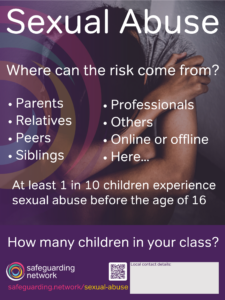Introduction
The National Analysis of Police-Recorded Child Sexual Abuse and Exploitation (CSAE) Crimes Report (2022) says in 2013, police forces across England and Wales recorded just over 20,000 crimes of child sexual abuse and exploitation. In 2022, they recorded almost 107,000 crimes.
Of the CSAE crimes recorded:
- 73% involved sexual offences committed directly against children;
- around 25% were offences related to indecent images of children;
- 52% involved reports of children (aged 10 to 17) offending against other children;
- 79% of recorded CSAE victims were female and 21% were male.
- the number of recorded incidents of online sexual abuse continues to grow and accounts for at least 32% of CSAE.
Need more?
Thank you for visiting our resources pages. These are free to everyone as is our fortnightly safeguarding bulletin – general safeguarding information is too important to restrict. Become a member to access lots more, including training materials for you to deliver in-house on each topic in Keeping Children Safe in Education.
Sign up for FREE fortnightly bulletin.
What about training?
We can deliver training for your setting on this and other subjects via online platforms, or face-to-face in certain areas. Just get in touch to discuss your requirements.
We know that the confidence of those working with children is lower when dealing with cases of sexual abuse than when dealing with other forms of abuse, so it’s important that you get regular training and support. You need to have a good knowledge of online safety as the internet continues to enable the reach of offenders to increase, and new developments in technology create new opportunities for perpetrators to exploit and abuse children.
Everyone working directly or indirectly with children must be able to identify the signs and respond to concerns of child sexual abuse. While this page provides brief information, you should also seek further advice.
Definition of child sexual abuse
“Sexual abuse involves forcing or enticing a child or young person to take part in sexual activities, not necessarily involving a high level of violence, whether or not the child is aware of what is happening.”
Child sexual abuse may involve physical contact (for example, penetration and oral sex) or non-penetrative acts such as masturbation, kissing, rubbing and touching outside of clothing.
It may also include non-contact activities, such as involving children in looking at (or in the production of) sexual images, watching sexual activities, encouraging children to behave in sexually inappropriate ways, or grooming a child in preparation for abuse.
Child sexual abuse is not solely perpetrated by adult males. Women can also commit acts of sexual abuse, as can other children (see our resource page on child-on-child abuse). Abuse can also be committed by adults who are in a position of trust or employed to work with children. It’s important to report all concerns – including low-level concerns.
The effects of sexual abuse in childhood are long lasting and can impact on adolescence and the ability of the individual to form healthy relationships in later life.
Online sexual abuse
As mentioned above, rates of online sexual abuse continue to grow. Online sexual abuse can be used to facilitate offline abuse (see our resource page about online safety and cybercrime) and also encompasses child sexual exploitation.
Developments in technology, such as virtual reality (VR) and artificial intelligence (AI), have provided new and increasingly wide-ranging opportunities to facilitate child sexual abuse and exploitation.
The 2022 Annual Report from the Internet Watch Foundation (IWF) reveals that the IWF assessed over 375,000 reports of online material suspected to contain child sexual abuse imagery and more than 250,000 of those reports were confirmed to contain images or videos of children suffering sexual abuse.
In 2023, the IWF also investigated child sexual abuse material (CSAM) generated by AI. AI CSAM can be indistinguishable from real images and is being created by both adults and children.
The IWF found examples of AI-generated images featuring known victims of CSA and celebrities and argues that there is now reasonable evidence that AI CSAM has increased the potential for re-victimisation.
Additional vulnerabilities
Any child can be at risk from sexual abuse. Some groups at increased risk include very young children, children with SEND, children in care and children experiencing other forms of abuse.
Identifying sexual abuse in children limited communication skills or learning difficulties is particularly challenging, and they may be at greater risk because the perpetrator may believe their victim does not have the capacity to communicate.
Spot the signs
Physical indicators
These include:
- soreness of the genital area and/or discharge;
- soiling or wetting the bed or clothes;
- sexually transmitted infections;
- recurrent abdominal pains;
- eating disorders;
- pregnancy.
Behavioural indicators
These include:
- having sexual knowledge beyond what would be expected for the age/stage of development;
- showing inappropriate sexual behaviour or language for their age/stage of development;
- being sexually active at a very young age;
- spending increased amounts of time online and/or being increasingly secretive or agitated about privacy;
- concerning sexual behaviour in adolescents;
- avoiding being alone with particular people;
- showing fear of individuals;
- depression;
- self-harm;
- aggressive, hostile, abusive behaviours;
- poor self-esteem.
Disclosures
A verbal disclosure may not always be forthcoming for several reasons. The lack of a verbal disclosure should not stop you considering the possibility of sexual abuse.
Children can struggle to report abuse; they may have been told they will not be believed, threatened by the perpetrator as part of the grooming process or told that they are to blame for the situation.
In Disclosing child sexual abuse: children and young people’s experiences, NSPCC Learning found children and young people listed various barriers to disclosure including developmental factors, isolation, and a lack of trusted and open relationships. To protect and support young people we must gain their trust and confidence to ensure we respond in an appropriate, effective and sensitive way.
We must know how to spot the signs of sexual abuse but also to understand how to promote opportunities and connections to help create safe spaces for children to disclose.
Children’s and young people’s experiences of disclosure are impacted by trauma, anxiety, and fear about the impact of other people learning about their abuse. Ineffective or insensitive responses can impact the likelihood of children and young people seeking help in the future.
Child sexual abuse is more commonly recognised by chance when someone notices physical signs, a change in behaviour, or a pattern of behaviour which leads them to suspect it.
Remember—children cannot consent to their own abuse.
What to do
- Listen to what children are saying, and consider the language used.
- Observe and note changes in behaviours/any unusual behaviours.
- Use the checklists above, and your safeguarding procedures, and consider sexual abuse as a possibility.
- Share concerns (including third-party allegations or other information) with your DSL at an early stage.
Promote safeguarding
Create an environment based on equality and informed choice – in an age-appropriate way, help children/young people to think about the issues and attitudes behind sexual abuse particularly regarding consent, gender and other equality issues.
Ensure young people know the risks – explain about privacy, safe touch, and how to recognise sexual abuse in an age-appropriate way.
Check young people have safe relationships – in their family, with other children/young people and with your staff. Create an environment where it is okay to talk, even about the most difficult things.
Know the signs and know what to do – use the checklists above, your safeguarding procedures and be confident to raise sexual abuse as a possibility.
Take action – and keep taking action until you know children and young people are safe.
Free child sexual abuse poster
This free, downloadable resource raises the profile of safeguarding for your staff team. For use in staff rooms, on safeguarding boards or on the back of toilet doors, the poster includes tips, a space for local contact details, plus a link and QR codes to this resource page. Download the poster from the resources below.
DSL Training Materials
-

Presentation
-

Presenter Notes
-

Handout for staff
-

Sexual abuse – Quiz
-

Sexual abuse – Quiz (Answer Sheet)
-

Sexual abuse scenario – EYFS settings
-

Sexual abuse scenario (EYFS) – DSL Information sheet
-

Sexual abuse scenario – Primary school
-

Sexual abuse scenario (primary) – DSL Information sheet
-

Sexual abuse scenario – Secondary Schools
-

Sexual abuse scenario (secondary) – DSL Information sheet
-

Sexual abuse scenario – 16+ settings
-

Sexual abuse scenario (16+) – DSL Information sheet
-

Sexual abuse scenario – SEND focus
-

Sexual abuse scenario (SEND focus) – DSL Information sheet
-

Sexual abuse scenario – Care Settings
-

Sexual abuse scenario (care settings) – DSL Information sheet
Resources
-

Sexual abuse poster
-

Signs and indicators template
-

Preventing the sexual abuse of disabled children
-

Stop Abuse Together
-

Safeguarding Insight – Child Sexual Abuse
-

Sexual Abuse – Early Years considerations
-

Childline – Healthy and unhealthy relationships
-

Take It down
-

Childline – Report Remove tool
-

A safe space for young people worried about sexual behaviour
-

CSA resources for education settings
-

IICSA Podcasts
-

Sexual abuse learning programme
Save time and improve your safeguarding approach…
Bite-size training materials to share with your staff every month.
Support to explore and develop your safeguarding culture.
A huge array of resources and professional experience at your fingertips.
Get in touch now for a personal tour of the site and details of membership benefits.
We look forward to working with you.


